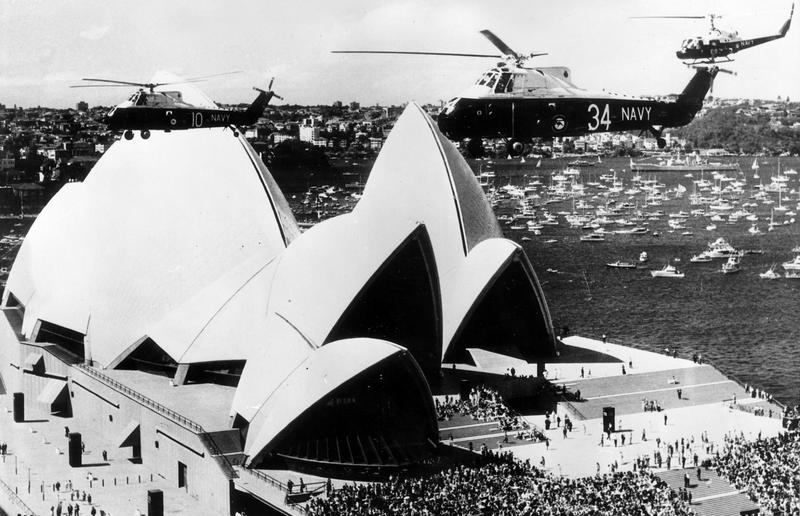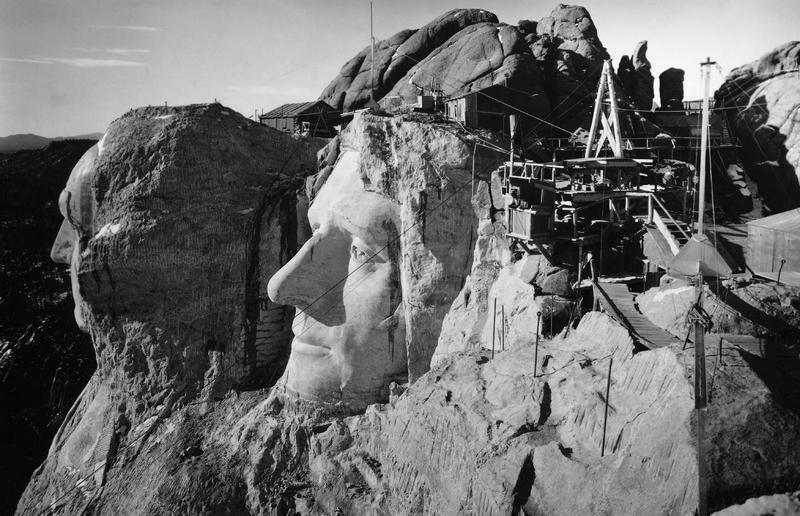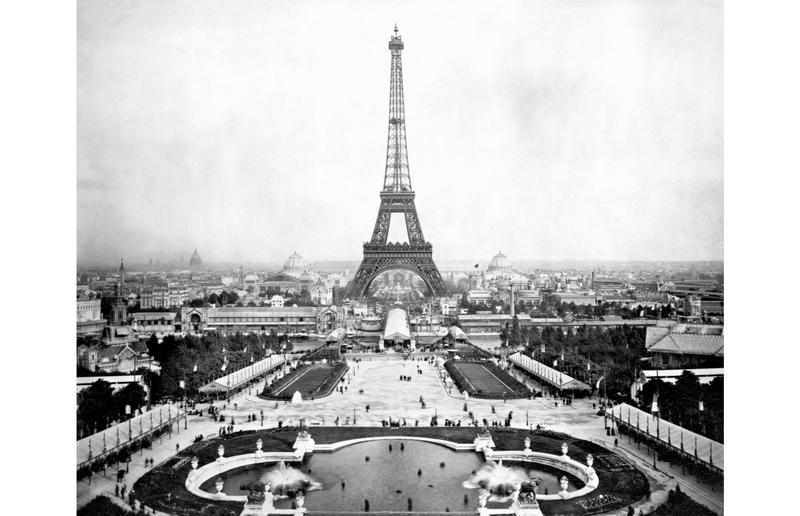Nostalgic Journey: Vintage Pictures Showcase the Beauty of World Landmarks
By Sophia Maddox | April 14, 2024
Sydney Opera House on Opening Day in 1973
Welcome to a captivating journey through time as we explore vintage photographs showcasing the world's most iconic landmarks. From the awe-inspiring pyramids of Egypt to the dynamic streets of New York City, each image encapsulates a moment in history, offering a glimpse into the remarkable achievements and cultural legacies of humanity. Join us as we uncover the fascinating stories behind these timeless treasures, delve into the mysteries of ancient civilizations, marvel at architectural marvels, and immerse ourselves in the vibrant tapestry of our global heritage.

Since its grand opening in 1973, the Sydney Opera House has graced the city's waterfront as an iconic symbol of artistic excellence and architectural innovation. Designed by Danish architect Jørn Utzon, this stunning structure has served as a cultural beacon, hosting some of the world's most renowned artists and performances. However, the path to its completion was not without challenges. Utzon's resignation and departure from Australia midway through construction, amid disputes with the Minister for Public Works, Davis Hughes, added a layer of complexity to the project's history.
Despite the tumultuous circumstances, the Sydney Opera House emerged as a triumph of human creativity and ingenuity. On its momentous opening day, 20 October 1973, the gleaming sails of the Opera House welcomed visitors from around the globe, symbolizing the city's vibrant cultural landscape and artistic vitality. Since then, it has become not only an architectural marvel but also a beloved landmark, captivating audiences with its breathtaking design and world-class performances. As Queen Elizabeth II officially inaugurated the Opera House, its significance as a cultural icon was solidified, marking the beginning of a new era in Sydney's cultural heritage.
The Early Days of Yellowstone National Park

Before it became the iconic Yellowstone National Park we know today, this vintage photo captures the rugged wilderness and early exploration of the region. Dating back to the Hayden Geological Survey of 1871, the image depicts men trekking through the untouched landscapes of what would soon be designated as the first National Park in the United States. Established in 1872, Yellowstone spans across northwestern Wyoming, with portions extending into Montana and Idaho. Despite its official recognition, tourism didn't flourish until the late 19th century when adventurous travelers arrived by rail or horse-drawn carriages. The true surge in visitors came with the allowance of cars in 1915, marking a new era of accessibility to the park's breathtaking geothermal wonders and diverse wildlife. Yet, long before the arrival of settlers, Yellowstone has been a sacred land, with indigenous peoples calling it home for thousands of years, a legacy that continues to be honored with ties to 26 tribes today.
Arc de Triomphe, Paris, France (1920s)

In this captivating photograph from the 1920s, a group of men engage in outdoor exercise beside the majestic Arc de Triomphe, a scene quite different from the bustling streets surrounding it today. Commissioned by Napoleon I in 1806 to commemorate the triumphs of the French army, particularly the victory at the Battle of Austerlitz in 1805, this iconic arch stands as a symbol of Parisian grandeur and military prowess. Spanning 30 years in construction, the Arc de Triomphe remains an enduring testament to France's rich history and cultural heritage. While modern-day visitors may find it challenging to partake in outdoor activities next to this historic landmark during peak seasons, the allure of the Arc de Triomphe continues to captivate admirers from around the world, beckoning them to bask in its timeless splendor and historical significance.
Mount Rushmore During Construction in 1940.

In this historic photograph from 1940, captured during the construction of Mount Rushmore, the majestic profiles of Thomas Jefferson and George Washington emerge from the rugged landscape of South Dakota's Black Hills. Carved between 1927 and 1941, this iconic monument pays homage to four revered presidents of the United States: George Washington, Thomas Jefferson, Theodore Roosevelt, and Abraham Lincoln. From the vantage point atop Lincoln's head, the painstaking craftsmanship and monumental scale of the project are evident, showcasing the dedication and vision of its creators.
Today, Mount Rushmore stands as a testament to American leadership and national pride, drawing approximately two million visitors annually to witness its awe-inspiring grandeur.
Great Sphinx of Giza, Egypt (1882)

This captivating image offers a glimpse into the allure of the Great Sphinx of Giza, a timeless symbol of Egypt's rich history. Standing proudly amidst the sands of the Giza plateau, this colossal statue, with the body of a lion and the face of a human, has fascinated visitors for millennia. Dating back over 4,500 years, the Sphinx remained partially shrouded in sand until the early 19th century when explorers embarked on the monumental task of excavation. Even in this 1882 image, taken after the Battle of Tel-El-Kebir and framed by British troops, the Sphinx's majestic form emerges from the earth, its ancient gaze holding timeless secrets amidst the changing tides of history.
Central Park, New York City (1894)

In this enchanting vintage photograph captured in 1894, Central Park comes to life as a bustling haven amid the urban landscape of New York City. Since its official opening in 1876, this verdant sanctuary has captured the hearts of New Yorkers, offering a myriad of activities to delight visitors of all ages. From leisurely gondolier trips on the tranquil lake to enchanting carriage rides and exhilarating model yacht racing, early patrons found endless joy and recreation within the park's 840 acres of lush greenery. Today, Central Park remains one of the world's premier attractions, welcoming an astounding 42 million visitors last year alone. Whether strolling along winding paths, picnicking on manicured lawns, or admiring the park's iconic landmarks, Central Park continues to enchant and inspire, serving as a timeless refuge amidst the bustling energy of the city that never sleeps.
Eiffel Tower, Paris, France (1889)

In this captivating vintage photograph taken in 1889, the iconic Eiffel Tower stands as a testament to Parisian ingenuity and architectural brilliance. Originally constructed between 1887 and 1889 as the centerpiece for the Paris World’s Fair, this towering masterpiece was initially intended to be a temporary exhibit. However, its mesmerizing beauty and structural innovation captured the hearts of Parisians and visitors alike. Despite plans to dismantle it in 1909 when its original licensing rights were set to expire, the Eiffel Tower was spared from destruction after city officials recognized its invaluable utility as a radio transmission station. Today, this symbol of elegance and engineering prowess continues to grace the Paris skyline, attracting approximately seven million visitors annually. From its humble beginnings as a temporary marvel to its status as a timeless icon, the Eiffel Tower stands as a symbol of Paris's enduring allure and cultural significance.
Coney Island, New York City (1946)

In this lively snapshot from 1946, daring park-goers embrace the exhilarating atmosphere of Coney Island, an iconic amusement park complex nestled in Brooklyn, New York City. For over 120 years, this vibrant destination has captivated thrill-seekers with its array of attractions and electrifying entertainment. Steeplechase Park, Luna Park, and Dreamland, the park's inaugural attractions, opened their gates in 1897, 1903, and 1904 respectively, ushering in a new era of excitement and adventure. Although Luna Park faced devastation from a fire in 1944, the spirit of Coney Island endured, attracting visitors from far and wide to experience its timeless charm and thrilling rides. Today, Coney Island remains a beloved symbol of fun and nostalgia, where the echoes of laughter and excitement continue to resonate through the generations.
Statue of Liberty at the Paris World’s Fair in 1878

In this remarkable vintage photograph captured during the 1878 Paris World’s Fair, the Statue of Liberty makes a stunning debut, far from the bustling streets of New York City where it would later find its permanent home. Originally conceived as a gesture of friendship and solidarity between France and the United States, the statue was gifted to America by the French in 1886, commemorating the alliance forged during the American Revolution. As the decades passed, the majestic figure, now residing proudly on Liberty Island, evolved into an enduring symbol of freedom and democracy, cherished by New Yorkers and admired by people around the globe.
Giza Pyramids, Egypt (1890)

In this captivating vintage photograph taken in 1890, the Giza Pyramids stand as silent sentinels, preserving the legacy of ancient Egypt's glory. Among the last surviving wonders of the ancient world, these majestic structures date back to the 4th dynasty, a testament to the enduring craftsmanship and architectural prowess of their creators. Towering over the desert sands, the three pyramids, dedicated to the pharaohs Khufu, Khafre, and Menkaure, have fascinated scholars and travelers for centuries. Originally towering at an impressive height of 481.4 feet (147 meters), they remain as enduring symbols of power and eternity. Despite their timeless allure, the pyramids' fortunes have fluctuated over the centuries. While the Egyptian government's efforts to promote tourism in 1975 led to a surge in visitor numbers, reaching a peak of 15 million in 2010, subsequent periods of political unrest and violence have caused fluctuations in tourism. Nevertheless, the Giza Pyramids continue to stand as unrivaled monuments to human achievement, beckoning travelers from across the globe to marvel at their ancient splendor.
St Basil’s Cathedral, Moscow, Russia (1890)

In this captivating vintage photograph captured in 1890, the resplendent St. Basil's Cathedral emerges like a vibrant gem amidst the historic streets of Moscow, Russia. Renowned for its striking multicolored spires and intricate patterns, this architectural marvel was commissioned by Ivan the Terrible to commemorate his victory over the Tatar stronghold of Kazan. Since its completion in 1560, St. Basil's has stood as an enduring symbol of Russian resilience and cultural heritage, captivating the imagination of visitors and locals alike. Despite its significance, it wasn't until the 1930s that the cathedral began to attract widespread tourism. In 1931, Intourist, a state-controlled travel company, launched a poster competition to promote travel within the Soviet Union, featuring Moscow's grand cathedral as a centerpiece. Today, St. Basil's Cathedral remains a must-see destination, drawing travelers from around the world to marvel at its timeless beauty and storied history.
Palace of Versailles, Paris, France (1895)

In this captivating vintage photograph captured in 1895, the opulent Palace of Versailles stands as a testament to the grandeur and excess of France's monarchy. With an astounding 2,300 rooms sprawling over 679,784 square feet (63,154 square meters), Versailles epitomizes the lavish lifestyle that ultimately fueled the flames of revolution. Originally commissioned by King Louis XIII in the 1630s, the palace underwent extensive expansions under the reigns of Louis XV and Louis XVI, further solidifying its status as a symbol of royal power and extravagance. However, as the monarchy's corruption and decadence reached its zenith, so too did the discontent of the French people, culminating in the tumultuous events of the French Revolution. Despite its troubled history, Versailles endured, evolving into a beacon of culture and artistry. In 1837, the inauguration of a museum within its walls marked the beginning of a new chapter, inviting visitors from around the world to marvel at its majestic halls and exquisite gardens. Today, the Palace of Versailles remains a cherished icon of French heritage, captivating millions of visitors each year with its timeless beauty and storied past.
Buckingham Palace during Queen Victoria’s Diamond Jubilee in 1897

In this captivating vintage photograph taken during Queen Victoria’s Diamond Jubilee in 1897, Buckingham Palace stands as a regal testament to the enduring legacy of the British monarchy. Since its transformation into the official residence of the Royal Family in 1837, the palace has served as a symbol of royal authority and tradition, remaining the administrative headquarters of the reigning monarch to this day. With its majestic facade and sprawling grounds encompassing 775 rooms across 39 acres, Buckingham Palace exudes timeless elegance and grandeur. Since 1993, the palace has opened its doors to the public each summer, offering visitors a glimpse into its storied history and opulent interiors. Another cherished tradition eagerly awaited by tourists is the daily Changing of the Guards Ceremony, a spectacle of military precision and pageantry performed outside the palace gates. As a beacon of British heritage and culture, Buckingham Palace continues to captivate visitors from around the world, inviting them to share in the majesty of its royal legacy.
Erechtheion Temple, Acropolis, Athens, Greece (1897)

Nestled atop the ancient limestone hill of the Acropolis in Athens, Greece, the Erechtheion Temple stands as a timeless testament to the enduring legacy of classical Greek civilization. Dating back to the Golden Age of Athens between 421 and 406 BC, this majestic temple is a masterpiece of architectural ingenuity and artistic craftsmanship. In this captivating vintage photograph from 1897, the Erechtheion Temple emerges from the ancient ruins, its iconic Caryatid Porch and elegant Ionic columns captivating the imagination of all who behold it.
The Acropolis itself, designated as a UNESCO World Heritage Site, holds a revered place in human history as one of the oldest and most famous archaeological sites in the world. Inhabited since prehistoric times, this sacred hill has witnessed the rise and fall of civilizations, serving as a symbol of Athenian democracy and cultural achievement.
Today, the Acropolis draws millions of visitors each year, drawn by its unparalleled beauty and historical significance.
Forbidden City, Beijing, China (1908)

Encircled by 2.17 miles (3.5km) of imposing citadel walls, the Forbidden City stands as a monumental symbol of China's imperial past in the heart of Beijing. Constructed between 1406 and 1420 under the auspices of the Yongle emperor of the Ming dynasty, this UNESCO World Heritage Site served as the epicenter of Chinese power for over five centuries, housing 24 emperors within its hallowed halls. In this evocative photograph from 1908, the Forbidden City appears in one of its final years as a functioning palace, witnessing the twilight of imperial rule as the Republic of China emerged, culminating in the overthrow of the last Qing emperor in 1911. Though its role as the seat of government ceased with the end of the monarchy, the Forbidden City endures as a cultural treasure, drawing visitors from across the globe to marvel at its majestic architecture and storied history, preserving the legacy of China's imperial heritage for generations to come.
Leaning Tower of Pisa, Italy (1960s)

In this intriguing snapshot from the 1960s, researchers from Pisa University's Geodesic and Topography Institute meticulously measure the ever-so-slight tilt of the iconic Leaning Tower of Pisa. Nestled in Tuscany, Italy, this architectural marvel continues to captivate with its gradual incline, a phenomenon studied annually to monitor its intriguing progression. Despite efforts to stabilize it, the tower's lean persists, serving as a testament to both human ingenuity and the enduring mysteries of engineering.
Christ the Redeemer, Rio de Janeiro, Brazil (1950s)

In this captivating photograph from the 1950s, tourists gather around the towering Christ the Redeemer monument, an iconic feature of Rio de Janeiro's skyline. Perched majestically atop Mount Corcovado, this 98-foot-tall (30m) statue stands as the largest Art Deco-style monument in the world, a testament to human creativity and faith. Surprisingly, the idea for this landmark had been brewing for over 70 years before construction finally commenced in 1922, with its inception dating back to the mid-1850s. Despite the lengthy journey from concept to completion, Christ the Redeemer endures as a symbol of resilience and devotion, welcoming visitors from around the globe to marvel at its imposing presence and breathtaking views of Rio de Janeiro below.
Taj Mahal, Agra, India (1960)

In this serene photograph captured in 1960, the Taj Mahal stands as a timeless testament to love and architectural splendor. Commissioned in 1632 by the Mughal emperor Shah Jahan as a memorial for his beloved wife, the Taj Mahal's breathtaking beauty continues to captivate visitors from around the world. Situated on the banks of the Yamuna River in Agra, India, this majestic edifice seamlessly blends Indian, Persian, and Islamic architectural influences, creating a harmonious masterpiece that transcends time and culture.
Despite its popularity as one of India's most cherished attractions, welcoming approximately three million visitors annually, this quiet moment captured in the photograph offers a glimpse of the Taj Mahal's serene grandeur.
Hollywood Sign, Los Angeles, California (1925)

In this captivating image from 1925, a group of surveyors poses underneath the towering "Hollywoodland" sign, a historic snapshot of Los Angeles's iconic landmark in its early days. Originally erected in 1923 as a temporary advertisement for a housing development, the sign underwent a transformation in 1949, shedding its "land" suffix to encompass the entire area and cementing its status as a symbol of Hollywood's global allure. Today, the Hollywood Sign stands as a quintessential backdrop, adorning countless tourist photographs and serving as a timeless beacon of the entertainment industry's glamour and prestige.
Stonehenge, Salisbury, England - Summer Solstice 1956

In this evocative photograph from Summer Solstice 1956, Druids gather at Stonehenge, Salisbury Plain's timeless enigma, to conduct the Dawn Ceremony, marking the longest day of the year. Dating back approximately 5,000 years to the Mesolithic Period, Stonehenge remains one of the world's most iconic prehistoric monuments. Composed of towering sarsen stones and enigmatic "bluestones" sourced from the distant Preseli Hills in Wales, Stonehenge continues to intrigue and mystify visitors with its ancient origins and celestial alignments.
The designation of Stonehenge as a UNESCO World Heritage Site in 1986 elevated its status as a global tourist destination, drawing admirers from across the globe to marvel at its ancient splendor and ponder the mysteries of its construction and purpose.

